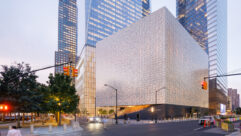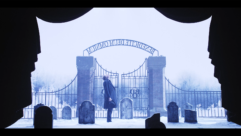SVC Podcast – Show Notes –
In this edition of the SVC Podcast, Contributing Editor Bennett Liles continues his conversation with Matt Peskie of Masque Sound about the renovation project for Baltimore Center Stage. Matt concentrates his account of the technical challenge of installing Dante-based DSP and ARC control remotes in the Head Theater and future-proofing it with OM4 fiber cable runs.
Links of Interest:
- Masque Sound – theatrical sound specialists
- Charcoalblue – acoustics and digital design firm on the project
- Middle Atlantic Products 44 RU WRK series racks
- Symetrix ARC-2e remote controls
- d&b Audiotechnik speakers installed in the Head Theater
Download Podcast Here:
https://s3.amazonaws.com/nb-svc/public/public/189-2_Center_Stage_Masque_…
This is the SVC Podcast from Sound & Video Contractor Magazine with Matt Peskie of Masque Sound. Show notes and product links for this and other SVC podcasts are at svconline.com.
Baltimore Center Stage has a newly renovated facility and a brand new sound setup in their Head Theater featuring Symetrix control, d&b Audiotechnik speakers and a DiGiCo mixer. They’ve got remote control all over the building installed by Masque Sound. Matt Peskie is back to finish up his story on how the whole project was finished. That’s coming up on the SVC Podcast.
Matt Peskie with Masque Sound in East Rutherford, New Jersey, thanks for getting back with us and we were talking last week about the Baltimore Center Stage whole building renovation including the Pearlstone Theater, the Head Theater and a sound system that extends control to locations everywhere. Matt, take us through what you did when you first got into the Head Theater.
Well, I guess the big thing with the Head initially was getting all the infrastructure laid out, which was part-and-parcel brought to us from the consultant, Charcoalblue. Once all that infrastructure was put in place then that really allows Amy, who is the audio head down there, and whoever is the visiting system designer is to lay out what they’re going to specifically put in for the show. Charcoalblue, I guess I should reface this with the kind of work on two different contracts when they do a project, at least in our past experience with them. The first contract would be the page program infrastructure and then along with a performance infrastructure. And then the second contract would actually be the fit out of all the equipment that would utilize that infrastructure and kind of give yourself a functional system. So I would say now they’re allowed – that infrastructure is there. Amy and whatever system designer comes in the place has the opportunity to take their plethora of d&b speakers, which they’ve got a multitude of different models, and pick and choose where to locate those for that specific show. So I think we talked about previously, Bennett, giving them the blank canvas and they can kind of paint as they choose. [Timestamp: 2:22]
A versatile system is certainly the bottom line on this one and I think it was the SymVue control panels. Is that what you put in there?
Yeah. That’s the touchscreen – well, not touchscreen per se, but the interactive control screen for Symetrix DSP. So basically in this scenario we gave them, I believe it’s around six different user pages to access different parts of the system in order to make changes be it a level control or be it routing control. I know we touched base that there’s a large Dante network put in place. So all of the speakers, say for example, in the lobby when you first come into the building, every speaker has essentially a level control handle that you can access through SymVue as well as you can choose what’s routed to that speaker. So you could choose to take the simple analog input, which there’s another selector further upstream that chooses what that analog input is, whether it’s the Head program or the Pearlstone program. Then we also put in a Dante input as well. So somebody could simply go onto the network with their computer using a virtual soundcard and choose to route that signal to a multitude of speakers or to just one speaker. In the lobby they’ve got three displays next to each other, each with a speaker. So they essentially could have a different program playing on every one of those speakers. [Timestamp: 3:45]
You deal with a lot of creative personalities in the theater business and this system allows them on the technical side to do whatever they come up with and channel that creativity through the whole system.
Yeah. From both the video and audio side, absolutely.
I also read about some portable stage manager cubes in the Head Theater. How did you set up and equip those?
Yeah, those are nice. They’ve got the Symetrix contact closure module inside of each one of them and they’ve got an arc controller. So it basically gives the stage manager the ability to use a custom LED panel that we put on the front of the rack and they can choose one of eight different zones where their page is going to go. So they can page either the Head house or the Pearlstone house or Head dressing rooms, Pearlstone dressing rooms, the lobby specifically, an all-page. So it kind of gives them the ultimate flexibility. And like I said we gave them a real nice custom LED touch panel. The buttons on the front, I believe they’re EAO buttons, so obviously you push them, they light up. It looks really nice. [Timestamp: 4:50]
And all of the available sound sources can be selected for monitoring all over the building in the various offices and dressing rooms. They can pull up sound from anywhere.
Yeah, yeah. Absolutely. And that’s convenient as well. There’s kind of three different volume control scenarios throughout the facility. They’ve got some of the Symetrix ARC-2 remotes, which are in the production manager offices and a couple of the rehearsal rooms where they’ve got like even or eight different choices. They can choose from for a source and then kind of the more traditional volume control, locations. Used the Atlas AT35 PA, so it’s got the priority relay at the volume control in itself. So they can use – they either choose the Head backstage or the Pearlstone backstage. And then in some of the more traditional offices they can just choose the program from each of the locations. So very easy to be in any office or any dressing room and monitor what’s happening in either one of the theaters. [Timestamp: 5:48]
And I would think they would really like the live video feeds from the stage so anybody backstage can see what’s going on out front.
Yeah. Yep, they’ve got video feeds throughout most of the dressing rooms, I believe. And I think they do a lot of stuff over their data network as well. [Timestamp: 6:02]
You chose Symetrix for the central control component. Was there a special reason for that or do you use that quite a bit?
We use it quite a bit and yeah, we’ve had nothing but great experience with their products. The SymVue pages, like I said, they’re very presentable. You can really lay them out to be very user-friendly and functional. And yeah, we’ve had nothing but good experience with their stuff. [Timestamp: 6:25]
This control and monitoring wiring is run all over the place so when you were installing all of it did you have to test it in stages or just put the whole thing together and then run it through and see how it all worked.
We do a little bit of both, actually. If we have some wires run, especially there was a lot of free air wire run on this project. There was a lot of wires specifically in the page program system. That was run free air so it’s not in conduit. Typically, in those situations we would try to test that cable before the ceiling gets closed just to verify that the cable didn’t get cut by another trade. But most of the other panels, like your typical kind of AV panel that’s got audio, coax, data, etc., that we would test once it’s terminated. And this is kind of one of those projects where we did a lot of terminations out in the field prior to everything totally terminated in the Head end. So it’s kind of wait until the Head end is terminated. Okay, we can go through and test these panels. Great, let’s test them. And then we kind of would sweep through after a panel was complete, with the exception of fiber, then we would do the fiber connection. So once that fiber was terminated and the panels closed and tested, no one is going back into the panel to possibly disturb the fiber terminations. [Timestamp: 7:41]
And once you got everything in and tested okay, how did the first production go with it?
It went really well, yeah. I think they’re on like number three or number four in the two different theaters now. So yeah, we’ve got nothing but good feedback from – and actually a couple of the shows have come through Masque here, that they’ve pulled some consoles and whatnot to send down there. So yeah, we’ve got nothing but great feedback. [Timestamp: 8:02]
And not only did the show work fine, you also got the craftsmanship award for that project. So what have you got coming down the line at Masque Sound?
We’ve got some exciting stuff. The Manhattan Class Company Theater, we’re in there working on that. That’s scheduled to open this coming year. And we just wrapped up a project at Fordham High School in the Bronx, which is a Bette Midler Foundation project which redo’s theaters and auditoriums in schools throughout the five boroughs. So we’re always happy to help out on that end of things. And yeah, lots of stuff coming up I’m sure this fall into next year. [Timestamp: 8:38]
Well it was certainly good to hear that everything worked fine. This was an especially challenging and far-ranging project not only due to the technical complexity and just the physical scope of it but also because of the versatility of it for the users. So it was great having you here to tell us about it. Matt Peskie from Masque Sound and the big renovation of Baltimore’s Center Stage, a project that rated a special craftsmanship award. Thanks for giving us the story on it.
Thanks, Bennett.
Thanks for joining us for Matt Peskie, Masque Sound and the Baltimore Center Stage Head Theater complete AV system renovation. We’ve got the show notes and product links at svconline.com. Get back with us right here again next week for the SVC Podcast.










